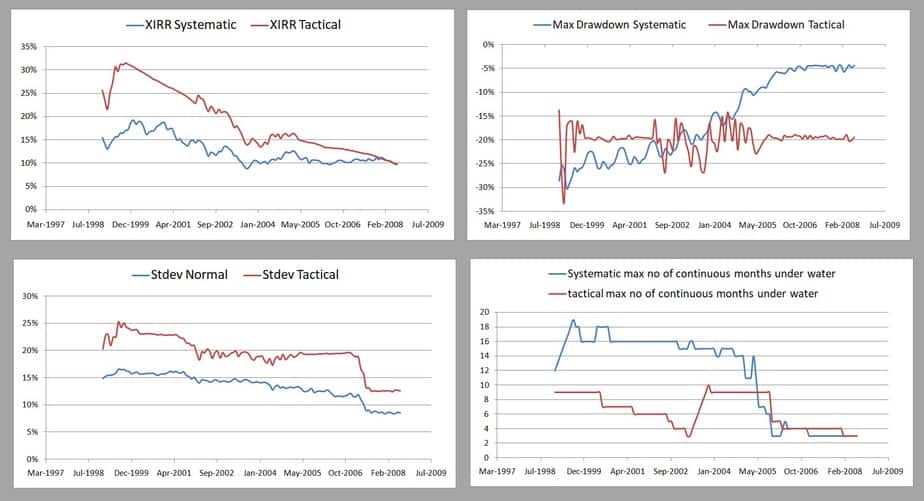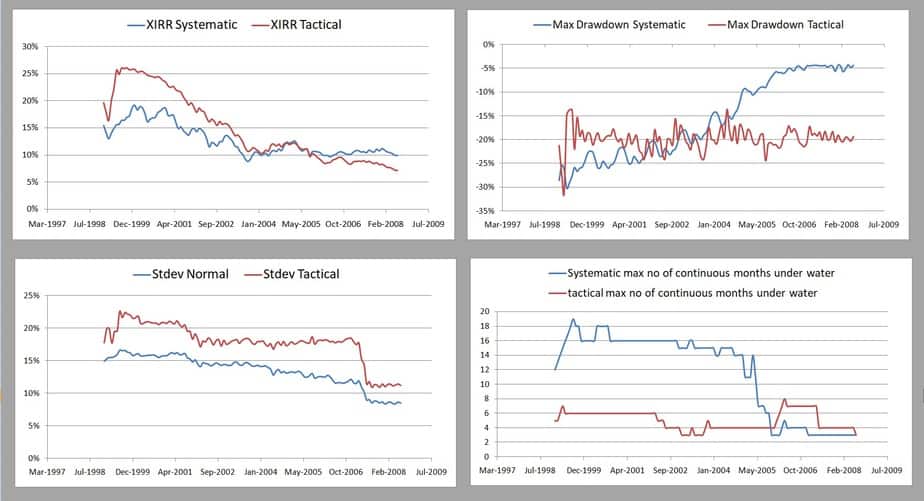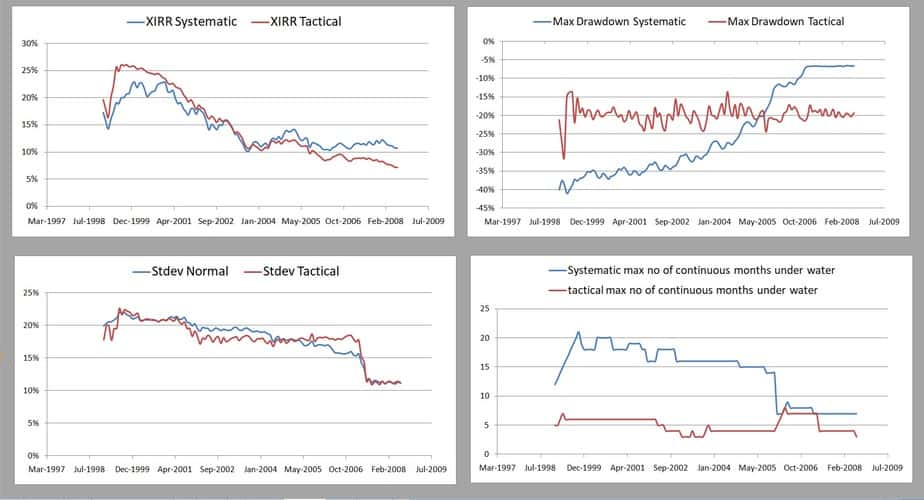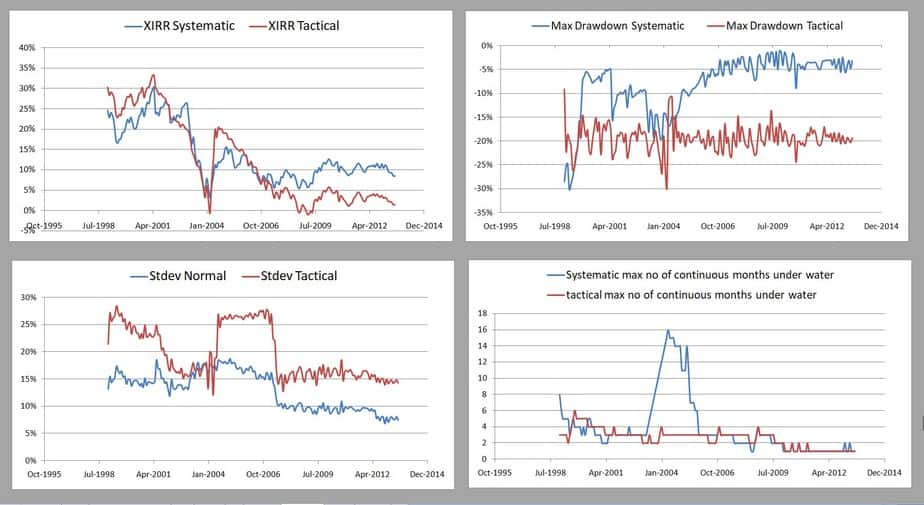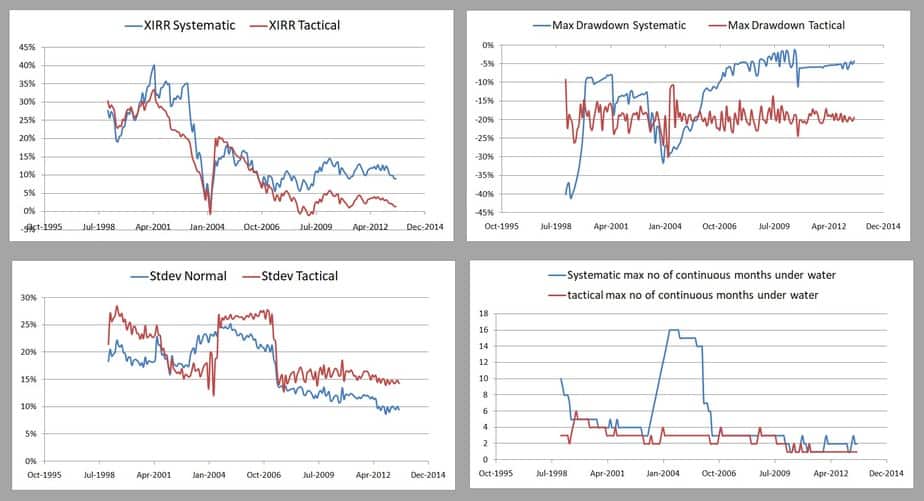Last Updated on January 6, 2022 at 7:56 am
In the 6th part on the series on tactical asset allocation techniques based on market timing, we evaluate the Motilal Oswal Value Index (MOVI) over five-year vs ten-year periods. The MOVI index data is available at the Motilal Oswal website used a combination of Nifty price to earnings ratio (PE), price to book value (PB) and dividend yield to compute how overheated the equity market is. The equity allocation in the portfolio is then decided based on this.
Since the exact formula of MOVI is not available in the public domain ( MO amc must be paying several lakhs to India Index Services and Products Ltd (IISL) for the index), I had previously tried to calculate it: Deconstructing the Motilal Oswal Value Index (MOVI). Before we look at MOVI market timing backtest, we need to cover some basic ground.
Warning and Disclaimer
The following is to be treated as investment research based on past data unrepresentative of practical implementation and is not investment advice. They do not factor in behavioural/emotional aspects associated with investing. If you do not know how to understand a backtest result, evaluate its disadvantages, then please, please DO NOT play with your money using market timing. Please watch this video before proceeding further.
Join 32,000+ readers and get free money management solutions delivered to your inbox! Subscribe to get posts via email! (Link takes you to our email sign-up form)
🔥Want to create a complete financial plan? Learn goal-based investing? Exclusive access to our DIY tools? Increase your income with your skills? Use this link to enjoy massive discounts on our robo-advisory tool & courses! 🔥
What is meant by tactical asset allocation (TAA)?
Asset allocation is the ratio of much equity, fixed income, gold, cash etc. is present in a portfolio. We will only consider equity and fixed income in this study. Tactical asset allocation (TAA) refers to changing these allocations based on certain factors or indicators.
What is market timing?
It is a technique to reduce portfolio risk and/or enhance portfolio returns by changing asset allocation based on our reading of where the market will head in the near future. This can be the stock market, bond market, gold market etc.
Is tactical asset allocation necessary?
Yes, as the risk associated with a portfolio must be systematically reduced or contained to ensure we have enough money for our future needs.
Is market timing necessary?
No. Tactical asset allocation is necessary and one need not resort to market timing to do this. TAA is possible based on a target corpus associated with a financial goal. See:
Part 1 How to reduce risk in an investment portfolio
Part 2 Do we need to time the market?
Part 3 Why we need to gradually pull out of equity investments well before we need the money!
Can we time the market?
Yes. However, realistic and reproducible market timing methods have often primarily reduced risk with or without return enhancement. See results here: Want to time the market with Nifty PE? Learn from Franklin Dynamic PE Fund and here: Is it possible to time the market?
Previous parts on the tactical asset allocation series1:
1: Do we need to time the market?
2: Market Timing with Index PE Ratio: Tactical Asset Allocation Backtest Part 1
3: Market Timing With Ten Month Moving Average: Tactical Asset Allocation Backtest Part 2
4: Tactical Asset Allocation Backtest Part 3: Short-Term Vs Long-Term
5: Buying on market dips: How effective is it?
MOVI Asset Allocation Rules
First, let us consider the rules mentioned at the MO website. Take the 90-day moving average of the MOVI index (movi-90ma).
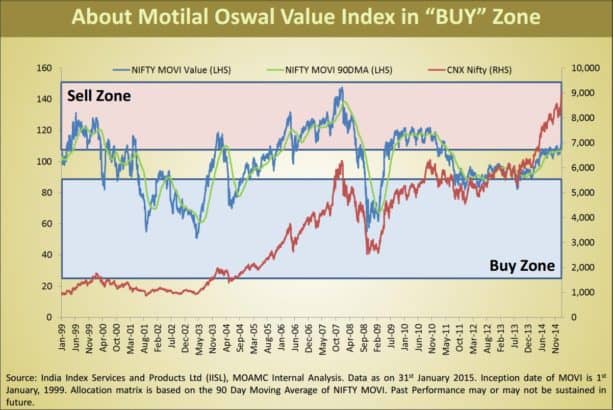
These are historic buy and sell zones of the MOVI. The actual equity asset allocation is:
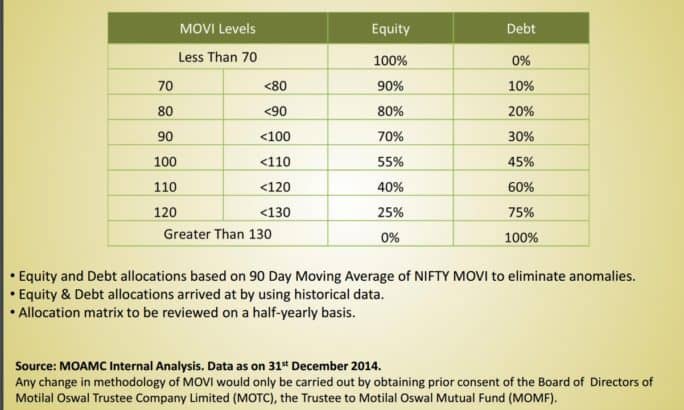
the MOST Dynamic equity fund uses an investment strategy similar to this.
Rules of Market Timing with MOVI (two-steps)
We will start off with a simple two-step rule. If movi-90ma < then sell all debt and invest in equity and systematically invest only in equity.
If movi-90ma is between 90 and 110, investment systematically in equity and debt. If movi-90ma> 110, then sell all equity and invest in debt and also invest systematically only in debt. We use Franklin India Blue Chip Fund for the Equity component and
Systematic investing A total amount of Rs. 1000 will be invested into the portfolio in a specified asset allocation (see below). The systematic portfolio will be rebalanced once a year. To account for exit loads and tax associated with this, the final portfolio amount will be reduced by 4%.
Tactical investing with the rules detailed above. The final tactical portfolio is reduced by 20% (this is 5 times the amount assumed for the systematic portfolio as the average no of trades in 10Y is about 5). This 20% accounts for exit loads of equity and fixed income and tax associated with equity. Remember equity was taxed like a debt fund before 2004 and will be again taxed from the current FY.
1 MOVI Timing: 10-years and 50% Equity and 50% debt (115 data points)
Top Left: The XIRR or returns are compared. Higher the better!
Top Right: The maximum fall of the portfolio from a peak is compared. The vertical axis is negative. So lower the value, the more the fall, the more the risk.
Bottom left: Standard deviation or how much the monthly returns fluctuate is compared. Higher the value, the higher the fluctuation, the higher the risk.
Bottom right: The no of months, the portfolio was continuously lower than a previous peak (underwater) is compared. Higher the no of months, higher the risk.
That is pretty good performance (return-wise), but MOVI timing, when done this way, does not exactly lower portfolio risk on a day to day basis but does decrease no of portfolio -ve returns.
In what follows, you will see graph after graph with not much commentary. This is deliberate. I prefer to let the pictures do the talking. Those who are interested will anyway look at them carefully.
2 MOVI-Timing: 10-years and 70% Equity and 30% debt
3 MOVI-Timing: 5-years and 50% Equity and 50% debt (175 data points)
4 MOVI-Timing: 5-years and 70% Equity and 30% debt
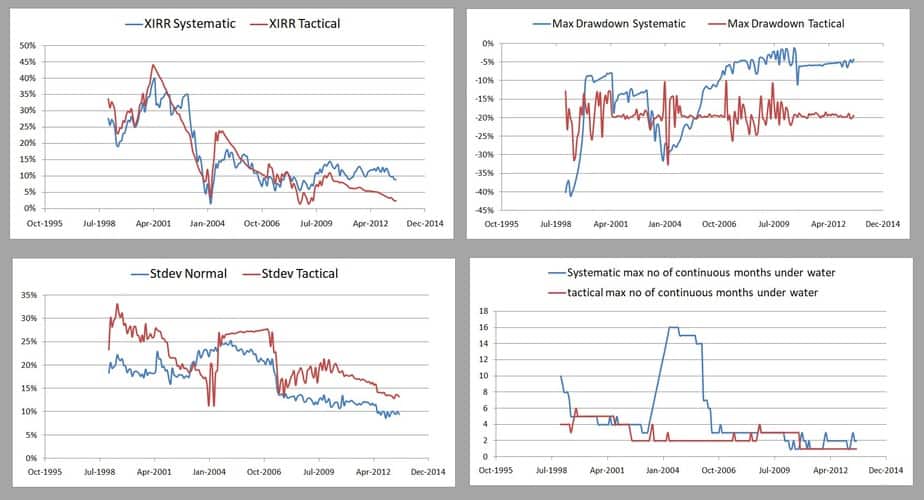
I would that is quite reasonable. Practically every TAA rule that I have backtested seems to have not got better returns in the recent past. Is this because the market has only moved up for the most part recently? Could be.
MOVI Timing Five Step Rules
1: If movi-90ma < 70: sell debt, invest in equity, systematically invest only in equity
2: If movi-90ma is between 70 and 90, rebalance such that equity is 80%. Also invest systematically in the same proportion.
3: If movi-90ma is between 90 and 110, rebalance such that equity is 55%. Also invest same systematically in the same proportion.
4: If movi-90ma is between 110 and 130, rebalance such that equity is 25%. Also invest systematically in the same proportion.
5: If move-90ma is greater than 130 then sell equity and invest in debt. Invest systematically only in debt.
When most investors find it daunting to follow a two-step process a 5-step process will be feared as too much work by many. Note that the actual movi rules contain more steps. Such multi-step TAA is well suited for pass-through instruments like mutual fund which do not have to pay tax and loads on each churn.
1 MOVI-Timing (5 steps): 10-years and 50% Equity and 50% debt
2 MOVI-Timing (5 steps): 10-years and 70% Equity and 30% debt 
3 MOVI-Timing (5 steps): 5-years and 50% Equity and 50% debt
4 MOVI-Timing (5 steps): 5-years and 70% Equity and 30% debt
Summary:
I think MOVI has fared quite decently in the past. Depending on how you implement rules it can either be high-risk with potential high-reward or low-risk with reasonable reward option (see the performance of MOST Dynamic Equity fund). This is, of course, true for any TAA rule. One big advantage with MOVI TAA is that the max no of months with no equity investment is quite low ~ 7-8 months. This is significantly lower than PE based timing. Please note that the systematic investing has been done with annual rebalancing. So do not assume you can leave it to chance and everything will turn out right.
What is my objective here?
Very few people are interested in posts such these. The reason I purse them is for my own satisfaction and search for a practical market timing method that will consistently lower risk and perhaps enhance reward. If you look at the number of months, the portfolio fell (negative returns) then clearly most TAA methods do well. The extra returns have also been decent. Of course on cannot guranteed that this will continue in future (in fact it has no even in the recent past). The hope is that if we lower risk, we can be calmer investors. The trouble is, most investors are lazy, worried about tax and loads and want lower risk and highe returns without effort. That I can say with certainity will not happen. Even if it does, it will be sheer pot luck.
My search continues. Many more methods to be tested.

Use our Robo-advisory Tool to create a complete financial plan! ⇐More than 3,000 investors and advisors use this! Use the discount code: robo25 for a 20% discount. Plan your retirement (early, normal, before, and after), as well as non-recurring financial goals (such as child education) and recurring financial goals (like holidays and appliance purchases). The tool would help anyone aged 18 to 80 plan for their retirement, as well as six other non-recurring financial goals and four recurring financial goals, with a detailed cash flow summary.
🔥You can also avail massive discounts on our courses and the freefincal investor circle! 🔥& join our community of 8000+ users!
Track your mutual funds and stock investments with this Google Sheet!
We also publish monthly equity mutual funds, debt and hybrid mutual funds, index funds, and ETF screeners, as well as momentum and low-volatility stock screeners.
You can follow our articles on Google News

We have over 1,000 videos on YouTube!

Join our WhatsApp Channel



- Do you have a comment about the above article? Reach out to us on Twitter: @freefincal or @pattufreefincal
- Have a question? Subscribe to our newsletter using the form below.
- Hit 'reply' to any email from us! We do not offer personalised investment advice. We can write a detailed article without mentioning your name if you have a generic question.
Join 32,000+ readers and get free money management solutions delivered to your inbox! Subscribe to get posts via email! (Link takes you to our email sign-up form)
About The Author
 Dr M. Pattabiraman (PhD) is the founder, managing editor and primary author of freefincal. He is an associate professor at the Indian Institute of Technology, Madras. He has over 13 years of experience publishing news analysis, research and financial product development. Connect with him via Twitter(X), LinkedIn, or YouTube. Pattabiraman has co-authored three print books: (1) You can be rich too with goal-based investing (CNBC TV18) for DIY investors. (2) Gamechanger for young earners. (3) Chinchu Gets a Superpower! for kids. He has also written seven other free e-books on various money management topics. He is a patron and co-founder of “Fee-only India,” an organisation promoting unbiased, commission-free, AUM-independent investment advice.
Dr M. Pattabiraman (PhD) is the founder, managing editor and primary author of freefincal. He is an associate professor at the Indian Institute of Technology, Madras. He has over 13 years of experience publishing news analysis, research and financial product development. Connect with him via Twitter(X), LinkedIn, or YouTube. Pattabiraman has co-authored three print books: (1) You can be rich too with goal-based investing (CNBC TV18) for DIY investors. (2) Gamechanger for young earners. (3) Chinchu Gets a Superpower! for kids. He has also written seven other free e-books on various money management topics. He is a patron and co-founder of “Fee-only India,” an organisation promoting unbiased, commission-free, AUM-independent investment advice.Our flagship course! Learn to manage your portfolio like a pro to achieve your goals regardless of market conditions! ⇐ More than 3,500 investors and advisors are part of our exclusive community! Get clarity on how to plan for your goals and achieve the necessary corpus no matter the market condition!! Watch the first lecture for free! One-time payment! No recurring fees! Life-long access to videos! Reduce fear, uncertainty and doubt while investing! Learn how to plan for your goals before and after retirement with confidence.
Increase your income by getting people to pay for your skills! ⇐ More than 800 salaried employees, entrepreneurs and financial advisors are part of our exclusive community! Learn how to get people to pay for your skills! Whether you are a professional or small business owner seeking more clients through online visibility, or a salaried individual looking for a side income or passive income, we will show you how to achieve this by showcasing your skills and building a community that trusts and pays you. (watch 1st lecture for free). One-time payment! No recurring fees! Life-long access to videos!
Our book for kids: “Chinchu Gets a Superpower!” is now available!


Must-read book even for adults! This is something that every parent should teach their kids right from their young age. The importance of money management and decision making based on their wants and needs. Very nicely written in simple terms. - Arun.Buy the book: Chinchu gets a superpower for your child!
How to profit from content writing: Our new ebook is for those interested in getting a side income via content writing. It is available at a 50% discount for Rs. 500 only!
Do you want to check if the market is overvalued or undervalued? Use our market valuation tool (it will work with any index!), or get the Tactical Buy/Sell timing tool!
We publish monthly mutual fund screeners and momentum, low-volatility stock screeners.
About freefincal & its content policy. Freefincal is a News Media organisation dedicated to providing original analysis, reports, reviews and insights on mutual funds, stocks, investing, retirement and personal finance developments. We do so without conflict of interest and bias. Follow us on Google News. Freefincal serves more than three million readers a year (5 million page views) with articles based only on factual information and detailed analysis by its authors. All statements made will be verified with credible and knowledgeable sources before publication. Freefincal does not publish paid articles, promotions, PR, satire or opinions without data. All opinions will be inferences backed by verifiable, reproducible evidence/data. Contact Information: To get in touch, please use our contact form. (Sponsored posts or paid collaborations will not be entertained.)
Connect with us on social media
- Twitter @freefincal
- Subscribe to our YouTube Videos
- Posts feed via Feedburner.
Our publications
You Can Be Rich Too with Goal-Based Investing
 Published by CNBC TV18, this book is designed to help you ask the right questions and find the correct answers. Additionally, it comes with nine online calculators, allowing you to create custom solutions tailored to your lifestyle. Get it now.
Published by CNBC TV18, this book is designed to help you ask the right questions and find the correct answers. Additionally, it comes with nine online calculators, allowing you to create custom solutions tailored to your lifestyle. Get it now.Gamechanger: Forget Startups, Join Corporate & Still Live the Rich Life You Want
 This book is designed for young earners to get their basics right from the start! It will also help you travel to exotic places at a low cost! Get it or gift it to a young earner.
This book is designed for young earners to get their basics right from the start! It will also help you travel to exotic places at a low cost! Get it or gift it to a young earner.Your Ultimate Guide to Travel
 This is an in-depth exploration of vacation planning, including finding affordable flights, budget accommodations, and practical travel tips. It also examines the benefits of travelling slowly, both financially and psychologically, with links to relevant web pages and guidance at every step. Get the PDF for Rs 300 (instant download)
This is an in-depth exploration of vacation planning, including finding affordable flights, budget accommodations, and practical travel tips. It also examines the benefits of travelling slowly, both financially and psychologically, with links to relevant web pages and guidance at every step. Get the PDF for Rs 300 (instant download)
